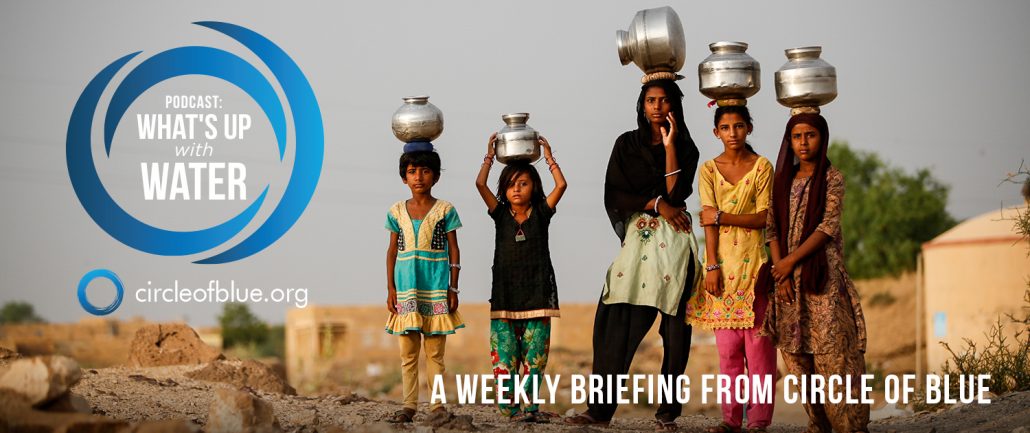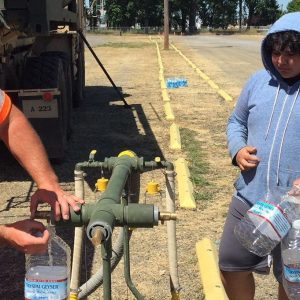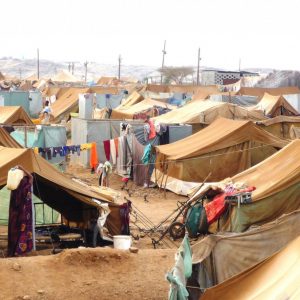
Transcripts
What’s Up With Water for June 18, 2018
I’m Eileen Wray-McCann, for Circle of Blue, and here’s What’s up with Water, your “need-to-know news” of the world’s water.
The leaders of Egypt and Ethiopia pledged to resolve their differences over Ethiopia’s massive new dam on the Nile River. The Grand Renaissance Dam, Ethiopia’s four billion dollar hydroelectric project, worries Egypt, which relies on the Nile for more than ¾ of its water. Experts say that the Nile’s flow could be significantly diminished if the dam’s reservoir is filled quickly. Ethiopia hopes to fill the reservoir over the course of three years. Egypt wants to stretch the task to 12 years.
Construction of the Grand Renaissance Dam began in 2011, and it is likely to be completed this year. It will be Africa’s largest dam, bringing electricity and economic growth to millions in Ethiopia.
Egypt and Sudan have been the main users of the Nile for irrigation and dams. With Ethiopia now emerging as a new player, tensions have risen, threatening political stability in the region. Egypt historically received a larger share of the Nile’s water, because of agreements that other nations in the river basin find unfair. Yet Egypt is also one of the world’s driest countries and faces increasing water stress.
Egypt, Ethiopia and Sudan have negotiated over the dam for months. Sudan seems to be siding with Ethiopia, and some see Ethiopia’s claim to water as a sign of a shifting balance of power from Egypt to the two upstream states. Past Egyptian presidents warned that they would oppose dams on the Nile with military force, but the current president, Abdel Fattah el-Sissi, has ruled this out. President el-Sisi and Ethiopian Prime Minister Abiy Ahmed held a joint press conference in Cairo last week, affirming a breakthrough in negotiations.
Prime Minister Ahmed assured Egyptians of Ethiopia’s commitment to their water. “We will take care of the Nile and we will preserve your share,” he said, “and we will work to increase this quota and President Sisi and I will work on this.”
In Pakistan, the lack of snowmelt and rain, coupled with unseasonable heat prompted officials to declare a drought alert.
Across the country, conditions constitute a water management emergency. Major reservoirs are nearing what local media term a “scarcity threshold” and researchers predict that Pakistan could become the most water-stressed country in the region.
The Pakistan Meteorological Department issued the drought alert, which is unusual for this time of the year because rivers are generally full from snowmelt in the north. The lack of snowmelt is a factor, but officials say the main cause is critically deficient rainfall. Last year’s monsoon brought only three-quarters of the average precipitation, and the winter rains were about half the average.
Experts warn that the trend is less water for more people. Last year, Pakistan’s population reached 208 million, and it is expected to double in the next 50 years. Climate change is predicted to further cut water availability.
Pakistan’s outgoing administration approved the country’s first National Water Policy, which is currently on hold, pending an election in July. The policy covers a multitude of issues including hydropower, trans-boundary water-sharing, irrigation, rain use, drinking water, sanitation and climate change. Opinions vary on the feasibility of its plans, with some critics calling for a narrower focus on key priorities, such as efficiency in agriculture, where most water is used.
Others propose tying the country’s water policy to the United Nations’ Sustainable Development Goals, already ratified by Pakistan, which offer a clear framework and ways to track progress. The next government will determine the water policy’s fate.
In the meantime, Pakistan’s farmers are scaling their crops back to conserve water. Monsoon season in late June should relieve some stress in the northern areas of the country, but rainfall is expected to be lower than average, which means farmers in the south will continue to suffer.
China and India resolved a dispute that had interrupted the sharing of data on two cross-border rivers. Until it abruptly stopped last year, China had provided data on the Brahmaputra and the Satluj (Sutlej) rivers to its neighbor downstream between May and October. This information was crucial during the monsoon season to help predict water flow and contend with flooding in India’s north-east.
Beijing blamed the suspension of data on technical issues. The suspension coincided with a standoff between Chinese and Indian troops over China’s attempt to extend a road into disputed territory.
China is building dams on the Brahmaputra, which is a concern for India over water access, but China says that the dams are only for generating power, not storing water.
In March, when officials discussed cooperation on emergency responses and sharing hydrological information, China said it would resume sharing data. Information from the Brahmaputra was shared in May, and the Sutlej in June. It will continue twice daily until October. The resumption of data coincides with an agreement between China and India to resume annual military exercises, which had been suspended due to the territorial standoff last year.
In the United States, Michigan is now enforcing the nation’s strictest standards for lead in drinking water, though some of the provisions will take decades to achieve. Last week, Governor Rick Snyder’s administration filed the regulations, saying that federal lead and copper rules do not do enough to protect public health. He said that Michigan could no longer afford to wait for the federal government to act.
The state action follows the water crisis in Flint, Michigan, that began in 2014, when a switch in the city’s water source and the failure to treat it to prevent corrosion caused lead contamination from the city’s aging pipes and fixtures.
The new Michigan plans call for lowering the “action level” for lead from the federal limit of 15 parts per billion to 12 parts per billion in 2025. And by 2040, all underground lead service lines that connect water mains to buildings will be replaced, with limited exceptions. Other rules are intended to assure a systematic approach to pipe replacement, accountability, testing, verification and education.
The plan could cost two and a half billion dollars over the decades of its implementation. Much of the cost is expected to be borne by water customers. Local governments and water utilities are critical of the new rules, saying they are a costly overreaction to a unique problem caused by inattentive authorities. Environmentalists applaud the rules, saying that Michigan will raise the bar for other states and the Environmental Protection Agency, which has been looking at changes to federal regulations.
And that’s What’s Up With Water…We’d like to share what’s up where you are – Tweet us with your water news: @circleofblue #whatsupwithwater.
Eileen Wray-McCann is a writer, director and narrator who co-founded Circle of Blue. During her 13 years at Interlochen Public Radio, a National Public Radio affiliate in Northern Michigan, Eileen produced and hosted regional and national programming. She’s won Telly Awards for her scriptwriting and documentary work, and her work with Circle of Blue follows many years of independent multimedia journalistic projects and a life-long love of the Great Lakes. She holds a BA and MA radio and television from the University of Detroit. Eileen is currently moonlighting as an audio archivist and enjoys traveling through time via sound.





